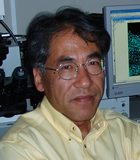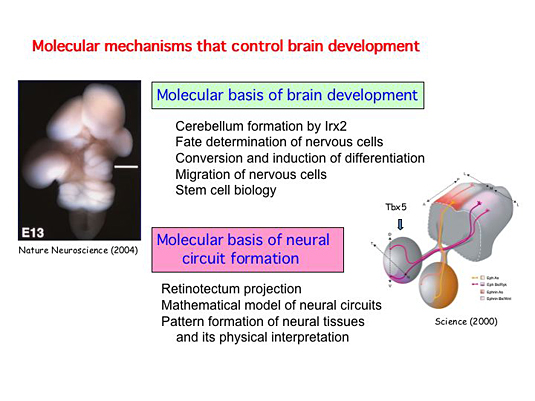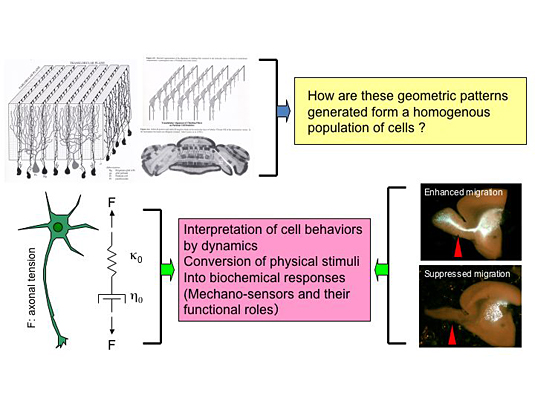Members
Toshihiko Ogura (Molecular Biology)

Prof. Ogura has graduated Tohoku University School of Medicine, been given PhD thesis (Immunology) from Kyoto University, and now is a professor of Institute of Development, Aging and Cancer, Tohoku University since 2003. His research covers broad areas of developmental biology, from cardiogenesis to neurogenesis. His lab is now focusing on re-interpretation of morphogenetic movement with different viewpoints, such as mathematics and dynamics, since Prof. Ogura and his colleagues have found that physical forces are an essential parameter of morphogenesis, homeostasis and metabolism. Prof. Ogura lab is now trying to open a new field that has never been explored. Prof. Ogura is a faculty member of Faculty of 1000 (Neurodevelopment section).
- Introduction of Research
-
Orchestration of differentiation, migration and re-assembly of cells is one of the most fundamental aspects of pattern formation of tissues and organs, including central nervous system. We thought that these coordinated behaviors of cells are regulated by a genetic program, in which pivotal genes regulate these steps in a tight and precise manner. This also implies that careful dissection of this genetic program and detailed analyses of functions of genes should help us to understand complicated morphogenesis of tissues and organs. Nonetheless, we have just come to a point to re-evaluate our approaches and to proceed to a new field, which has never been explored.
Pattern formation, such as the Benard convection and the Taylor instability, is also extensively studied in physics and chemistry. In these cases, a homogenous group of molecules can form orderly patterns. In another case, oxidative and reductive states repeat in an oscillatory way, known as the (Belousov-Zhabotinsky) B-Z reaction. These indicate that autonomous mechanisms do exist even in developing embryos, some of which were already studied extensively by Turing and Meinhard.
We have been exploring molecular mechanisms of pattern formation of vertebrate embryos, with central nervous system, limb bud and heart as model organs, and with several key transcription factors as our keen interest. Nonetheless, we have noticed that extensive analyses on the genetic programs are not sufficient for understanding thoroughly the dynamic pattern formation of developing embryos. Recently, we have identified that several proteins change their shapes and conformation in response to physical forces that are generated by cells, hereby such strains trigger next biochemical responses. We are now studying this novel mechanism to understand functional roles of physical forces generated by cells and sensed by cells.

1) Molecular mechanisms of brain formation. Induction of cerebellum by an Iroquois homeodomain transcription factor, Irx2. Fate determination of neural stem cells and their differentiation and migration.
2) Molecular mechanisms of neural network formation. Retinotectum projection regulated by Tbx5. Migration of neuronal cells.
In cerebellum, neural networks and arrangement of cells are highly ordered to form mathematical and geometrical patterns. Such patterns are formed by orchestrated migration of cells and dynamic changes of cell shapes. We believe that such fundamental processes should be re-evaluated by mathematics and mechanics.
- Articles
-
- Daam1 regulates the endocytosis of EphB during the convergent extension of the zebrafish notochord.
Yasuyuki S. Kida, Takayuki Sato, Kota Y. Miyasaka, Asami Suto and Toshihiko Ogura Proc. Natl. Acad. Sci. USA 104, 6708-6713 (2007) - Tbx genes specify posterior digit identity through Shh and BMP signaling. Takayuki Suzuki, Jun Takeuchi, Kazuko Koshiba-Takeuchi, and Toshihiko Ogura Developmental Cell 6, 43-53 (2004)
- The Iroquois prepattern gene Irx2 induces the complete transformation of tectum to cerebellum.
Ken Matsumoto, Shigeki Nishihara, Mika Kamimura, Takao Otoguro, Masayuki Uehara, Yukiko Maeda, Keiko Ogura, Andrew Lumsden, and Toshihiko Ogura Nature Neuroscience 7: 605-612, 2004. - Tbx5 and the retinotectum projection.
Koshiba-Takeuchi, K., Takeuchi, J.K., Matsumoto, K., Momose, T., Uno, K., Hoepker, V., Ogura, K., Takahashi, N., Nakamura, H., Yasuda, K. and Ogura, T. Science 287、134-137 (2000) - Tbx5 and Tbx4 genes determine the wing/leg identity of limb buds.,
Takeuchi JK, Koshiba-Takeuchi K, Matsumoto K, Vogel-Hopker A, Naitoh-Matsuo M, Ogura K, Takahashi N, Yasuda K, Ogura T Nature 398, 810-814 (1999)
- Daam1 regulates the endocytosis of EphB during the convergent extension of the zebrafish notochord.